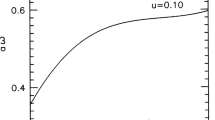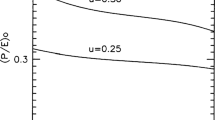Abstract
We study analytic core-envelope models obtained in Negi et al. (1989) under slow rotation. We have regarded in the present study, the lower bound on the estimate of moment of inertia of the Crab pulsar, \(I_{\mathrm{Crab},45} \geq 2\) (where \(I_{45}=I/10^{45}~\mbox{g}\,\mbox{cm}^{2}\)) obtained by Gunn and Ostriker (Astrophys. J. 157:1395, 1969) as a round off value of the recently estimated value of \(I_{\mathrm{Crab},45} \geq 1.93\) (Bejger and Haensel, Astron. Astrophys. 405:747, 2003) for the Crab pulsar. If this value of lower bound is combined with the other observational constraint obtained for the Crab pulsar (Crawford and Demianski, Astrophys. J. 595:1052, 2003), \(G_{h} = I_{\mathrm{core}}/I_{ \mathrm{total}} \geq 0.7\) (where \(G_{h}\) is called the glitch healing parameter and represents the fractional moment of inertia of the core component in the starquake mechanism of glitch generation), the models yield the mass, \(M\), and surface redshift, \(z_{a}\), for the Crab pulsar in the range, \(M = 1.79M_{\odot }\mbox{--}1.88M_{\odot }\); \(z_{a} = 0.374\)–0.393 (\(I_{45} = 2\)) for an assigned value of the surface density, \(E_{a} = 2\times 10^{14}~\mbox{g}\,\mbox{cm}^{2}\) (like, Brecher and Caporaso, Nature 259:377, 1976). This assigned value of surface density, in fact, is an outcome of the first observational constraint imposed on our models that further yields the mass \(M = 1.96M_{\odot }\) and surface redshift \(z_{a}=\) 0.414 (\(I_{45}= 2\)) for the values of \(G_{h} \approx 0.12\), which actually belongs to the observed ‘central’ weighted mean value for the Vela pulsar. These values of mass and surface redshift predict the energy of a gravitationally redshifted electron-positron annihilation line, \(E (\mathrm{{MeV}) = 0.511/(1+z_{a})}\) (Lindblom, Astrophys. J. 278:364, 1984) in the range about 0.396–401 MeV from the Crab and about 0.389 MeV from the Vela pulsar. The evidence of a line feature at about 0.40 MeV from the Crab pulsar (Leventhal et al., Astrophys. J. 216:491, 1977) agrees quite well with the finding of this study.







Similar content being viewed by others
References
Andersson, N., Glampedakis, K., Ho, W.C., Espinoza, C.M.: Phys. Rev. Lett. 109, 241103 (2012)
Arnett, W.D., Bowers, R.L.: Astrophys. J. Suppl. Ser. 33, 415 (1977)
Baldo, M.: In: Baldo, M. (ed.) Nuclear Methods and the Nuclear Equation of State, p. 1. World Scientific, Singapore (1999)
Baldwin, J.E.: In: Davies, R.D., Smith, F.G. (eds.) The Crab Nebula, IAU Sym., vol. 46, p. 22 (1971)
Bejger, M., Haensel, P.: Astron. Astrophys. 405, 747 (2003)
Borner, G.: Springer Tracts in Modern Astrophysics, vol. 69. Spinger, Berlin (1973)
Brecher, K., Caporosso, G.: Nature 259, 377 (1976)
Chamel, N.: Phys. Rev. Lett. 110, 011101 (2013)
Chandrasekhar, S., Miller, J.C.: Mon. Not. R. Astron. Soc. 167, 63 (1974)
Cohen, J.M., Cameron, A.G.W.: Astrophys. Space Sci. 10, 227 (1971)
Crawford, F., Demianski, M.: Astrophys. J. 595, 1052 (2003)
Datta, B., Alpar, M.A.: Astron. Astrophys. 275, 210 (1993)
Delsate, T., Chamel, N., Gürlebeck, N., Fantina, A.F., Pearson, J.M., Ducoin, C.: Phys. Rev. D 94, 023008 (2016)
Durgapal, M.C., Pande, A.K., Fuloria, R.S.: Astrophys. Space Sci. 102, 49 (1984)
Goldreich, P., Julian, H.W.: Astrophys. J. 157, 867 (1969)
Gunn, J.E., Ostriker, J.P.: Astrophys. J. 157, 1395 (1969)
Haensel, P.: In: Hankins, T.H., Rankin, J.M., Gil, J. (eds.) The Magnetospheric Structure and Emission Mechinisms of Radio Pulsars. IAU Colloq., vol. 128, p. 217. Pedagogical University Press, Zielona Gora (1990)
Hartle, J.B.: Astrophys. J. 50, 1005 (1967)
Hartle, J.B., Sharp, D.H.: Phys. Rev. Lett. 15, 909 (1965)
Haskell, B., Khomenko, V., Antonelli, M., Antonopoulou, D.: Mon. Not. R. Astron. Soc. 481, L146 (2018)
Irvine, J.M.: Neutron Stars. Oxford University Press, Oxford (1978)
Kalogera, V., Baym, G.: Astrophys. J. 470, L61 (1996)
Lai, X.Y., Yun, C.A., Lu, J.G., Lü, G.L., Wang, Z.J., Xu, R.X.: Mon. Not. R. Astron. Soc. 476, 3303 (2018)
Leventhal, M., MacCallum, C.J., Walba, A.C.: Astrophys. J. 216, 491 (1977)
Li, A., Dong, J.M., Wang, J.B., Xu, R.X.: Astrophys. J. Suppl. Ser. 223, 16 (2016)
Lindblom, L.: Astrophys. J. 278, 364 (1984)
Negi, P.S.: Mon. Not. R. Astron. Soc. 366, 73 (2006)
Negi, P.S.: Astrophys. Space Sci. 332, 145 (2011)
Negi, P.S., Pande, A.K., Durgapal, M.C.: Class. Quantum Gravity 6, 1141 (1989)
Shapiro, S.L., Teukolsky, S.A.: Black Holes, White Dwarfs, And Neutron Stars: the Physics of Compact Objects. Wiley, New York (1983)
Sharma, B.K., Centelles, M., Vinas, X., Baldo, M., Burgio, G.F.: Astron. Astrophys. 584, 103 (2015)
Steiner, A.W., Gandolfi, S., Fattoyev, F.J., Newton, W.G.: Phys. Rev. C 91, 015804 (2015)
Wiringa, R.B., Fiks, V., Fabrocini, A., Phys. Rev. C 38, 1010 (1988)
Zhou, E.P., Lu, J.G., Tong, H., Xu, R.X.: Mon. Not. R. Astron. Soc. 443, 2705 (2014)
Acknowledgements
We are grateful to Dr. P.K. Mishra and G. Punetha for providing LaTeX package. The anonymous Referee is acknowledged for his valuable comments and suggestions which helped us to improve the present paper.
Author information
Authors and Affiliations
Corresponding author
Additional information
Publisher’s Note
Springer Nature remains neutral with regard to jurisdictional claims in published maps and institutional affiliations.
Rights and permissions
About this article
Cite this article
Negi, P.S. Analytic core envelope models for the Crab and the Vela pulsars. Astrophys Space Sci 364, 149 (2019). https://doi.org/10.1007/s10509-019-3638-5
Received:
Accepted:
Published:
DOI: https://doi.org/10.1007/s10509-019-3638-5




